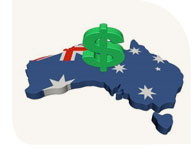|
|

  Market Analysis
Dynamic AUD 
USD turns significantly weak at the end of the third quarter. The major reason is market's anticipation of the second phase of quantitative easing from the U.S. Federal Reserves. Based on the experience in 2008 and 2009, the purchasing power of USD would be seriously undermined under quantitative easing, thus led to the depreciation of USD. Risky assets are the beneficiaries under ample currency supply, especially the commodity sector.
Australian dollar (AUD) is the best performer among commodity currencies this year. It has appreciated by 8% year to date. The Australian economy benefits from the Commodity Super Cycle. For instance, the demand of commodities from China has contributed to a robust Australia. According to a web news report on Bloomberg on
21 September 2010, Australia raised the forecast of commodity exports till the end of June 2011 to AUD214.9 billion, which was only AUD170.6 billion in the previous year. Due to the large commodity demand from China, the Australian economy is highly correlated to China's economy. The rebound of economic figures of China at the end of the third quarter, such as purchasing manager index and industrial production data, offers good support to AUD.
After the financial crisis in 2008, Australia is the first country to lift up its interest rate and also is one of the countries which lifts up the most. Hence, besides its sound economic fundamental, the interest rate differential also underpins AUD. Recently, market turns to a bullish view on Australia's interest rate prospect due to re-accelerating economic data. Market thus buying AUD on expecting that the Reserve Bank of Australia will raise interest rate again this year. AUD is currently at 0.9750 against USD, which is close to pre-financial crisis' high at 0.9850.
In the short term, AUD may have fully reflected the good news on the exchange rate. 0.9850 to 1.0, the pre-financial crisis' high and the psychological level, should be a strong resistance to AUD, especially right after a rapid surge. Nevertheless, if there is a reasonable retracement and consolidation, market may focus back to Australia's solid fundamental and interest rate differential among the others. If market still has rate hike expectation at that time, AUD will still have much attraction due to furthering widening of interest rate differential. Perhaps it has to wait until the U.S. starts its hiking cycle then the trend of AUD will be changed.
| Source: |
Treasury Product Management (Investment)
Global Markets, BOCHK |
Risk Disclosure:
This document is prepared for reference purpose only. The above views are the personal opinions of the author. The content herein is not intended to provide professional or investment advice and should not be relied upon as such. This document is prepared on the basis of materials obtained from sources believed to be reliable but accepts no liability in relation to the use of this document or the content herein for any purpose. The Bank does not make any representation or warranty and accept no responsibility or liability as to the accuracy, completeness or correctness of the content herein. The content herein is subject to change without notice. You are advised to seek independent financial and professional advice before you trade or invest. You should carefully consider whether trading or investment is suitable in light of your own financial position and investment objectives. This document does not constitute an offer or an invitation to any person to sell, purchase, subscribe or transact any product or service mentioned herein. Investment involves risk. The prices of securities, funds and other investment products may fluctuate, sometimes dramatically. The price of securities, funds and other investment products may move up or down, and may become valueless. It is likely that losses will be incurred rather than profits made as a result of buying and selling securities, funds and other investment products. Past performance is not indicative of future performance. You should carefully read the offering documents for details before making any investment decision. The Bank, its related companies, their directors and/or employees may have positions in, and may effect transaction in, the products and services mentioned herein. Foreign currency investments are subject to exchange rate fluctuations which may provide both opportunities and risks. The fluctuation in the exchange rate of foreign currency may result in losses in the event that the customer converts the foreign currency into Hong Kong dollars or other foreign currencies. Bank of China (Hong Kong) Limited will not be liable for the quality of products and services provided by the participating merchants. The tables and diagrams are for reference only.
|













 Market Analysis
Market Analysis 

